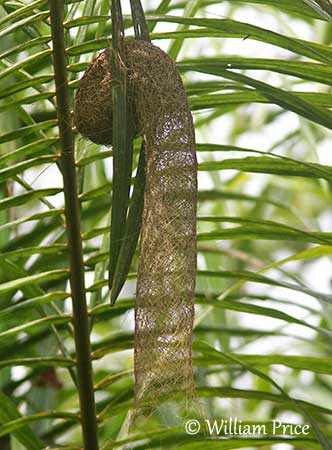
The semi-transparent entrance tube may look delicate, but it is very robust. It is made with nicely woven palm fibres or vine tendrils. The bird arriving at nest in flight dives upwards into the tube with closed wings through the flared entrance. Then, it clambers up to the egg-chamber with its feet.
The female lays two pure white eggs.
No more information.
PROTECTION / THREATS / STATUS:
The Red-vented Malimbe has large range in which it is common. The population is apparently stable and the species is not globally threatened and currently evaluated as least Concern.
Fr: Malimbe à queue rouge
Ang: Red-vented Malimbe
All: Rotsteißweber
Esp: Malimbo Culirrojo
Ita: Malimbe culorosso
Nd: Schildprachtwever
Sd: rödgumpad malimbe
Photographers:
William Price
PBase-tereksandpiper & Flickr William Price
Dubi Shapiro
Dubi Shapiro Photo Galleries & Dubi Shapiro's Pictures on IBC
Text by Nicole Bouglouan
Sources:
HANDBOOK OF THE BIRDS OF THE WORLD Vol 15 by Josep del Hoyo-Andrew Elliot-David Christie - Lynx Edicions – ISBN: 9788496553682
BIRDS OF AFRICA SOUTH OF THE SAHARA by Ian Sinclair and Peter Ryan - Princeton University Press Princeton and Oxford - ISBN: 0691118159
L’ENCYCLOPEDIE MONDIALE DES OISEAUX - Dr Christopher M. Perrins - BORDAS - ISBN: 2040185607
Bird nests: Variety is Key for the world’s avian Architects
Weaver Watch - Red-vented Malimbe Malimbus scutatus
Wikipedia, the free encyclopaedia
CREAGUS@Monterey Bay (Don Roberson)
Red-vented Malimbe
Malimbus scutatus
Passeriformes Order – Ploceidae Family
INTRODUCTION:
The Red-vented Malimbe is a member of the family Ploceidae, subfamily Ploceinae, including the typical weavers. It occurs in the West African lowland forests where it forages high in trees, gleaning insects or catching them by aerial sallies.
This species is well known for the distinctive shape of its nests, a woven structure like an “inverted sock” built by both mates in palm trees.
The Red-vented Malimbe has stable population and is common throughout its wide range.
DESCRIPTION OF THE BIRD:
Biometrics:
Length: 17 cm
Weight: 28-33 g
The Red-vented Malimbe adult male of nominate race has black plumage except the scarlet-red forehead, crown, nape, breast and undertail-coverts. On the head, lores, cheeks, ear-coverts, chin and throat are black.
The bill is black. The eyes are brown to dark chestnut-brown. Legs and feet are black.

The adult female has black head with sometimes scattered red feathering. She has a broad red patch on the breast, sharply demarcated at base of the throat.
The juvenile is dull black on both upperparts and underparts. Forehead, lores, cheeks, chin, throat, upper breast and undertail-coverts are bright orange to red. The bill is pale brown or horn-coloured. The eyes are dark grey-brown. Legs and feet are dark brown.
SUBSPECIES AND RANGE:
The Red-vented Malimbe has two subspecies.
M.s. scutatus or Western Red-vented Malimbe, is found in Sierra Leone, SE Guinea, Liberia, S Ivory Coast and SW Ghana.
M.s. scutopartitus or Eastern Red-Vented Malimbe, occurs in SE Benin, S Nigeria and SW Cameroon.
This race is slightly larger than nominate and the red breast patch is broader in both male and female, but that of the female shows central black line.
HABITAT:
The Red-vented Malimbe frequents the rainforest, old secondary growth and gallery forest, swamp forest, clearings and forest edges and wooded savannas.
It lives near palm trees and nests in them, both in forest and open, cultivated fields and near villages. It forages high in trees in the upper strata in forest. The species occurs from sea-level up to 1,000 metres of elevation on Mt Cameroon.

CALLS AND SONGS: SOUNDS BY XENO-CANTO
The Red-vented Malimbe is usually located by the loud, rasping typical calls “zii-zii-zii-zii” or “chit-it-zeer-zeer” given by the birds while moving through the forest. We can also hear a hard “tuk tuk-tuk tuktuktuk tuk” and a single, nasal “zuweeya”.
The song is usually melodious and consists of repeated phrases “peeyo-peeyo-tsitsi-pyurr-tsu-wee-tsurr-tsurr-tsu-wee-tsitsi-wer”.
BEHAVIOUR IN THE WILD:
The Red-vented Malimbe feeds primarily on insects and caterpillars by gleaning and some aerial sallies. But it also consumes the husks of oil palm nuts.
It usually forages in the canopy of the mature forest, highest of any Malimbus species, up to 30 metres height, especially in the thin outermost twigs where it feeds in tit-like manner.

They can be seen in small groups of 5-6 individuals, or in larger flocks according to the range. They continuously utter rasping calls while moving through the understorey, often near villages.
The Red-vented Malimbe is monogamous. The courtship displays of the members of the subfamily Ploceinae involve male chasing and then, approaching the female, usually far from the nest-site. Then, nest-invitation display may occur to attract the female. The male may also perform aerial displays over its territory, followed by perched courtship within the territory.
The suspended nest is built by both mates. They are solitary nesters.
The Red-vented Malimbe is sedentary.
The flight is fast with shallow wingbeats.

REPRODUCTION OF THIS SPECIES:
The breeding season varies with the range, and occurs in February in Guinea, in December in Ghana, and between September and February in Nigeria.
The monogamous pair may build several nests (3-7) in the same tree, but only one will be used. Both mates take part in nest-building, and one nest took three weeks to complete.
The woven “inverted sock” has globular egg-chamber and very long entrance tube of more than 60 centimetres, but it is generally shorter. Such nest is suspended from two adjacent palm leaflets or the tips of the leaflets, in the high strata of the canopy, from six metres height to the upper canopy.
